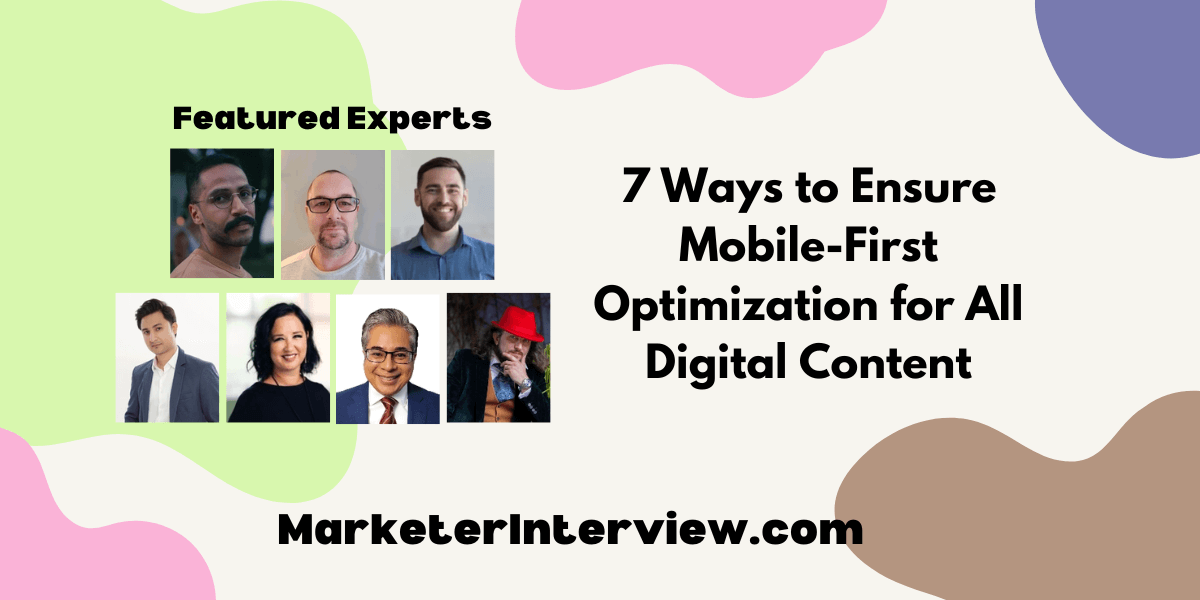7 Ways to Ensure Mobile-First Optimization for All Digital Content
In the ever-evolving digital landscape, ensuring mobile-first optimization is crucial. We’ve gathered specific tips from CEOs, SEO Consultants, and other experts to guide you. From embracing the “Thumb Zone” to minimizing intrusive pop-ups, discover seven key techniques to enhance your mobile digital content.
Want to get quoted in MarketerInterview.com content just like this? Apply to become a contributor today!
Contents
Embrace the “Thumb Zone”
One golden nugget for ensuring mobile-first optimization is to embrace the ‘thumb zone.’ Think about how people naturally hold their phones and navigate with their thumbs. Design your content so that the most important buttons, links, and calls to action are within easy reach of the thumb.
I once worked with a local coffee shop that saw a 30% increase in mobile orders simply by moving their order button to the thumb-friendly zone. It’s all about making the user experience as seamless and intuitive as possible.
When users can effortlessly tap their way through your site, they’re more likely to stick around, engage, and convert. So, give those thumbs a break and watch your mobile engagement soar!

Lukasz Zelezny, SEO Consultant, SEO ANT LTD
Design for Smallest Screens First
Start with simplicity: design for the smallest screen first, ensuring that essential content and functionality are prioritized. This approach forces a focus on what truly matters, making the transition to larger screens seamless and effective. Mobile-first isn’t just a strategy; it’s about providing a superior user experience everywhere.

Khurram Suhrwardy, CEO, Caption Easy
Reverse Design Process
Often, designers will use powerful tools to design websites and other content on a desktop. When they’re satisfied, they’ll then adjust their designs for mobile. While popular, this isn’t “mobile-first.” Instead, start with a mobile design.
When you’re satisfied, expand it for tablet and desktop experiences. By reversing the order of your design process, you’ll have a “mobile-first” mindset. This will translate to ensuring a good experience on mobile.
From there, any expansions for larger devices will enhance the experience further. This is a much better process than cutting out design elements to make your design fit a mobile screen.

Dennis Consorte, Digital Marketing and Leadership Consultant for Startups, Snackable Solutions
Implement Micro-Modularity
For my team and me, adopting a mobile-first optimization strategy across every content asset and campaign touchpoint has become an absolute mandate, given the shift in device usage behavior to smartphones as the consumption epicenter. While multifaceted disciplines realign from desktop defaults, one creative technique proving highly effective is what I term “micro-modularity.”
Essentially, the methodology involves structuring any core content piece—whether long-form guides, short-form social posts, or campaign landing pages—as compartmentalized modules mapped to distinct canvases based on device display constraints. We blueprint the schematic first, mapping facets like intro summaries, key benefit explanations, supporting visuals, calls-to-action, etc., to an information architecture free of length or format restrictions initially.
From that agnostic content inventory, we architect streamlined variations for lean smartphone renditions, stripping non-essentials and enhancing scannability through concise paragraphs, tight list bullets, and bold highlight annotations. Tablet editions scaffold intermediate detail bridges, while desktop versions can house depth. But every element maps to open templates, putting critical mobile priority at the creative nucleus regardless.

Yvonne Meredith, Marketing Manager, MJ Flood Security
Focus on Mobile Loading Speed
It is important to understand the importance of mobile-first optimization for all digital content. With more and more people accessing information on their mobile devices, having a website that is optimized for mobile is crucial for any business’s success.
One specific tip or technique for ensuring mobile-first optimization for all digital content is to prioritize loading speed. Mobile users tend to have a shorter attention span and are more likely to abandon a website if it takes too long to load. Therefore, it is important to optimize images and other media, minimize JavaScript and CSS files, and utilize caching techniques to improve loading speed for mobile users.
Another tip is to design with responsive layouts in mind. This means creating a website that can adapt fluidly to different screen sizes without sacrificing functionality or user experience. This can include using a flexible grid system, setting appropriate font sizes, and utilizing responsive images.
Additionally, incorporating mobile-friendly features such as easy navigation, large clickable buttons, and simplified forms can greatly improve the user experience for mobile users. It is also important to regularly test your website on different devices and make necessary adjustments to ensure it looks and functions well on all screen sizes.

Alex Taylor, Head of Marketing, CrownTV
Minimize Intrusive Pop-Ups
Not only from my perspective as a business professional but also as a consumer, I understand that minimizing pop-ups is really important for ensuring mobile-first optimization because intrusive pop-ups can significantly disrupt someone’s experience on mobile devices.
On smaller screens, pop-ups often occupy a large portion of the display, making it difficult for consumers to access the content they are interested in. This frustration can lead to higher bounce rates and lower engagement, ultimately harming a brand’s reputation. In a mobile-first world, it’s essential to provide a smooth, uninterrupted browsing experience that keeps people engaged and satisfied with the content.
Brands can successfully minimize pop-ups by implementing less intrusive alternatives, such as using in-line forms or slide-in calls-to-action that appear at the bottom of the screen. Timing is also key, as setting pop-ups to appear after a user has spent a certain amount of time on the page or has scrolled to a particular section can make them less intrusive. Also, providing clear and easy ways to close pop-ups, such as a prominent “X” button, ensures that anyone can quickly dismiss them if they choose, making it a less frustrating experience.

Wayne Mills, Head of Operations, Seven Seas Worldwide
Embrace Vertical Scrolling
On mobile devices, people are accustomed to scrolling vertically to navigate through content, unlike traditional desktop browsing where horizontal navigation is more common. By embracing vertical scrolling, businesses can present information in a single, continuous flow, eliminating the need for complex navigation structures that can hinder user experience on smaller screens.
This approach allows for efficient utilization of limited screen space, enabling businesses to prioritize essential content while maintaining a clean and clutter-free layout. And, vertical scroll design enhances content discoverability and encourages users to explore further, facilitating engagement and driving conversions.
To implement vertical scroll design effectively, businesses should prioritize content hierarchy, placing the most critical information at the top of the page to capture users’ attention immediately. Utilizing a single-column layout ensures that content flows seamlessly from top to bottom, optimizing readability and minimizing user effort.
Businesses should also employ visual cues such as section breaks, headings, and multimedia elements to break up the content and guide users through the scrolling experience. It’s essential to strike a balance between providing enough content to inform and engage users while avoiding overwhelming them with excessive information.

Renan Ferreira, Head Of Communications and Director Of Sales, RealCraft
Want to get quoted in MarketerInterview.com content just like this? Apply to become a contributor today!






